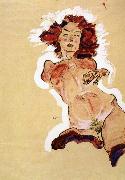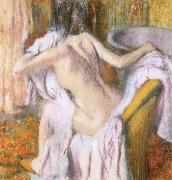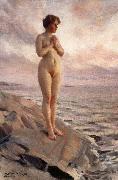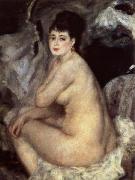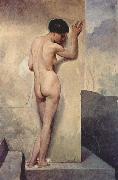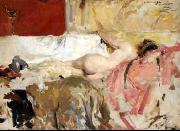Wholesale Oil Painting No Minimum |
|||||||||||
|
|
|||||||||||

|
|||||||||||
|
|
|
||||||||
Eduardo Rosales GallinasSpanish , Madrid, 1836 - Madrid, 1873 |
||||||||
|
|
||||||||
Female Nude
Female Nude Painting ID:: 28764 |
mk61
1869
Oil on canvas
185x95cm
mk61 1869 Oil on canvas 185x95cm |
|||||||
|
|
||||||||
Egon Schiele1890-1918 Austrian Egon Schiele Gallery Egon Schiele (12 June 1890 ?C 31 October 1918) was an Austrian painter, a protege of Gustav Klimt, and a major figurative painter of the early 20th century. Schiele's body of work is noted for the intensity and the large number of self-portraits he produced. The twisted body shapes and the expressive line that characterize Schiele's paintings and drawings make the artist an early exponent of Expressionism, although still strongly associated with the art nouveau movement (Jugendstil). The most important collection of Schiele's work is housed in the Leopold Museum, Vienna. In 1907, Schiele sought out Gustav Klimt. Klimt generously mentored younger artists, and he took a particular interest in the gifted young Schiele, buying his drawings, offering to exchange them for some of his own, arranging models for him and introducing him to potential patrons. He also introduced Schiele to the Wiener Werkstätte, the arts and crafts workshop connected with the Secession. In 1908 Schiele had his first exhibition, in Klosterneuburg. Schiele left the Academy in 1909, after completing his third year, and founded the Neukunstgruppe ("New Art Group") with other dissatisfied students. Sitzender weiblicher Akt, 1914Klimt invited Schiele to exhibit some of his work at the 1909 Vienna Kunstschau, where he encountered the work of Edvard Munch, Jan Toorop, and Vincent van Gogh among others. Once free of the constraints of the Academy's conventions, Schiele began to explore not only the human form, but also human sexuality. At the time, many found the explicitness of his works disturbing. |
||||||||
|
|
||||||||
|
|
Female Nude
Female Nude Painting ID:: 47939 |
mk189
1910
mk189 1910 |
||||||
|
|
||||||||
Edgar DegasFrench Realist/Impressionist Painter and Sculptor, 1834-1917 French painter, draughtsman, printmaker, sculptor, pastellist, photographer and collector. He was a founder-member of the Impressionist group and the leader within it of the Realist tendency. He organized several of the group exhibitions, but after 1886 he showed his works very rarely and largely withdrew from the Parisian art world. As he was sufficiently wealthy, he was not constricted by the need to sell his work, and even his late pieces retain a vigour and a power to shock that is lacking in the contemporary productions of his Impressionist colleagues. |
||||||||
|
|
||||||||
|
|
Female nude
Female nude Painting ID:: 48722 |
mk191
1880
Oil on canvas
104x98.5cm
mk191 1880 Oil on canvas 104x98.5cm |
||||||
|
|
||||||||
Anders ZornSwedish 1860-1920 Swedish painter, etcher and sculptor. He was brought up by his grandparents at Mora. As he displayed a precocious talent for drawing he was admitted to the preparatory class of the Kungliga Akademi for de Fria Konsterna, Stockholm, at the age of 15. Dissatisfied with the outdated teaching and discipline of the Academy and encouraged by his early success as a painter of watercolour portraits and genre scenes (e.g. Old Woman from Mora, 1879; Mora, Zornmus.) Zorn left the Academy in 1881 to try to establish an international career. He later resided mainly in London but also travelled extensively in Italy, France, Spain, Algeria and the Balkans and visited Constantinople. However, he continued to spend most of his summers in Sweden. |
||||||||
|
|
||||||||
|
|
Female Nude
Female Nude Painting ID:: 51796 |
mk221
1910
Oil on canvas
64.8x43.2cm
Sweden
1860-1920
mk221 1910 Oil on canvas 64.8x43.2cm Sweden 1860-1920 |
||||||
|
|
||||||||
Pierre-Auguste RenoirFrench Impressionist Painter, 1841-1919 French painter, printmaker and sculptor. He was one of the founders and leading exponents of IMPRESSIONISM from the late 1860s, producing some of the movement's most famous images of carefree leisure. He broke with his Impressionist colleagues to exhibit at the Salon from 1878, and from c. 1884 he adopted a more linear style indebted to the Old Masters. His critical reputation has suffered from the many minor works he produced during his later years. |
||||||||
|
|
||||||||
|
|
Female Nude
Female Nude Painting ID:: 53996 |
mk245
1876
Oil on canvas
92x73cm
mk245 1876 Oil on canvas 92x73cm |
||||||
|
|
||||||||
Francesco Hayez1791-1882 Italian Francesco Hayez Galleries Hayez came from a relatively poor family from Venice. His father was of French origin while his mother, Chiara Torcella, was from Murano. The child Francesco, youngest of five sons, was brought up by his mother sister, who had married Giovanni Binasco, a well-off shipowner and collector of art. From childhood he showed a predisposition for drawing, so his uncle apprenticed him to an art restorer. Later he became a student of the painter Francisco Magiotto with whom he continued his studies for three years. He was admitted to the painting course of the New Academy of Fine Arts in 1806, where he studied under Teodoro Matteini. In 1809 he won a competition from the Academy of Venice for one year of study at the Accademia di San Luca in Rome. He remained in Rome until 1814, then moved to Naples where he was commissioned by Joachim Murat to paint a major work depicting Ulysses at the court of Alcinous. In the mid 1830s he attended the Salotto Maffei salon in Milan, hosted by Clara Maffei (whose portrait Hayez painted for her husband), and he was still in Milan in 1850 when he was appointed director of the Academy of Brera there. Assessment of the career of Hayez is complicated by the fact that he often did not sign or date his works. Often the date indicated from the evidence is that at which the work was acquired or sold, not of its creation. Moreover he often painted the same compositions several times with minimal variations, or even with no variation. His early works show the influence of Ingres and the Nazarene movement. His later work participates in the Classical revival. |
||||||||
|
|
||||||||
|
|
Female Nude
Female Nude Painting ID:: 59314 |
Female Nude (c. 1859)
Pinacoteca di Brera, Milan
Female Nude (c. 1859) Pinacoteca di Brera, Milan |
||||||
|
|
||||||||
Joaquin SorollaSpanish Realist/Impressionist Painter, 1863-1923 |
||||||||
|
|
||||||||
|
|
Female Nude
Female Nude Painting ID:: 97183 |
1886(1886)
Medium oil on canvas
Dimensions 25.125 X 32.625 in
cyf 1886(1886) Medium oil on canvas Dimensions 25.125 X 32.625 in cyf |
||||||
|
|
||||||||
|
Joaquin Sorolla Spanish Realist/Impressionist Painter, 1863-1923 Female Nude 1886(1886) Medium oil on canvas Dimensions 25.125 X 32.625 in cyf |
||||||||
|
|
||||||||
|
Prev Next
|
||||||||
|
|
||||||||
|
Related Paintings to Joaquin Sorolla :. |
||||||||
|
|
||||||||
|
CONTACT US |


